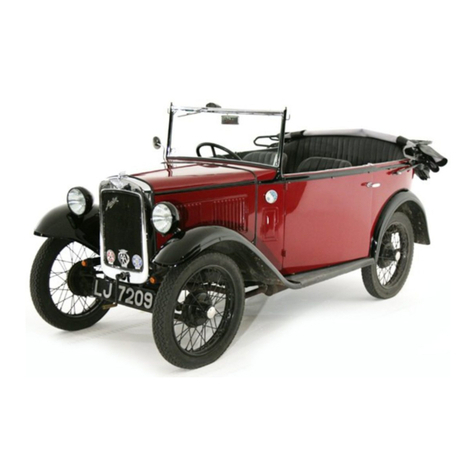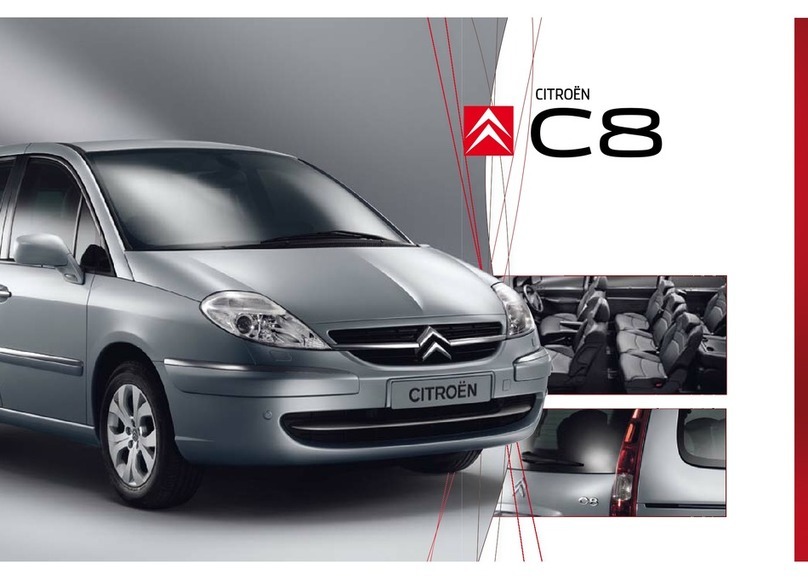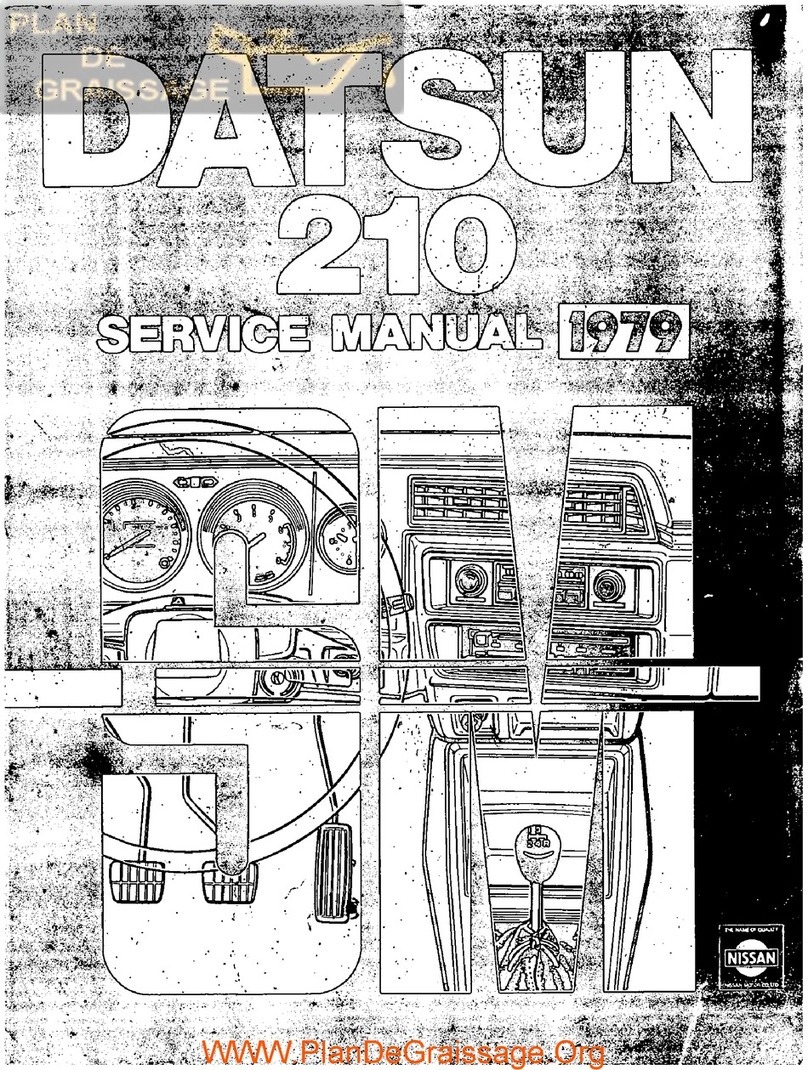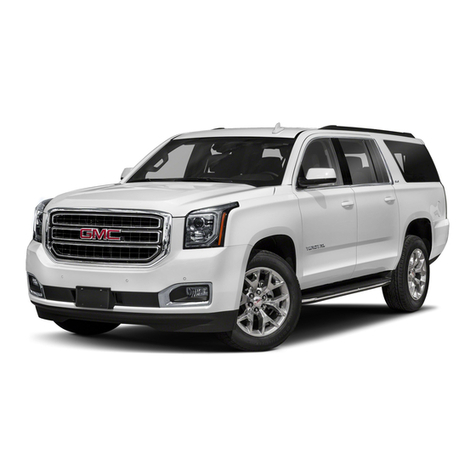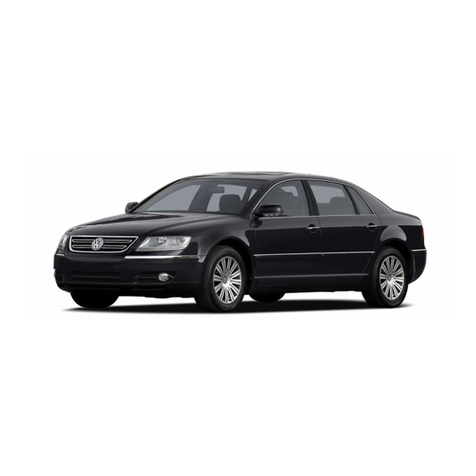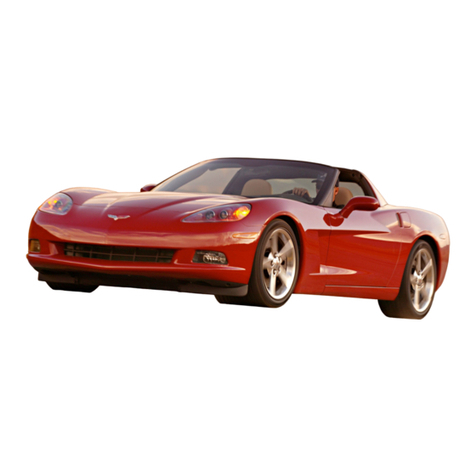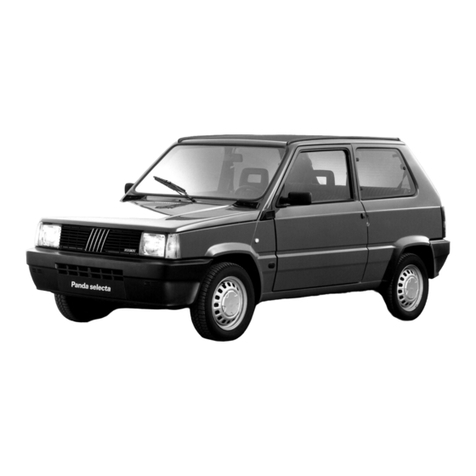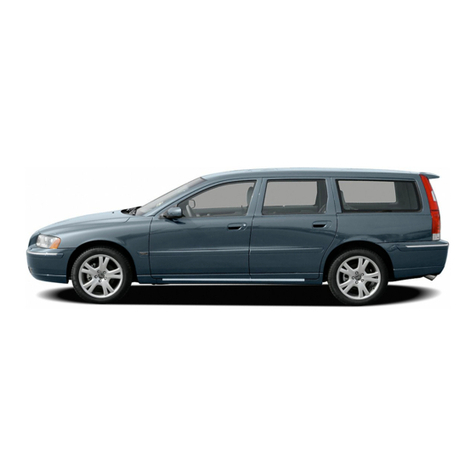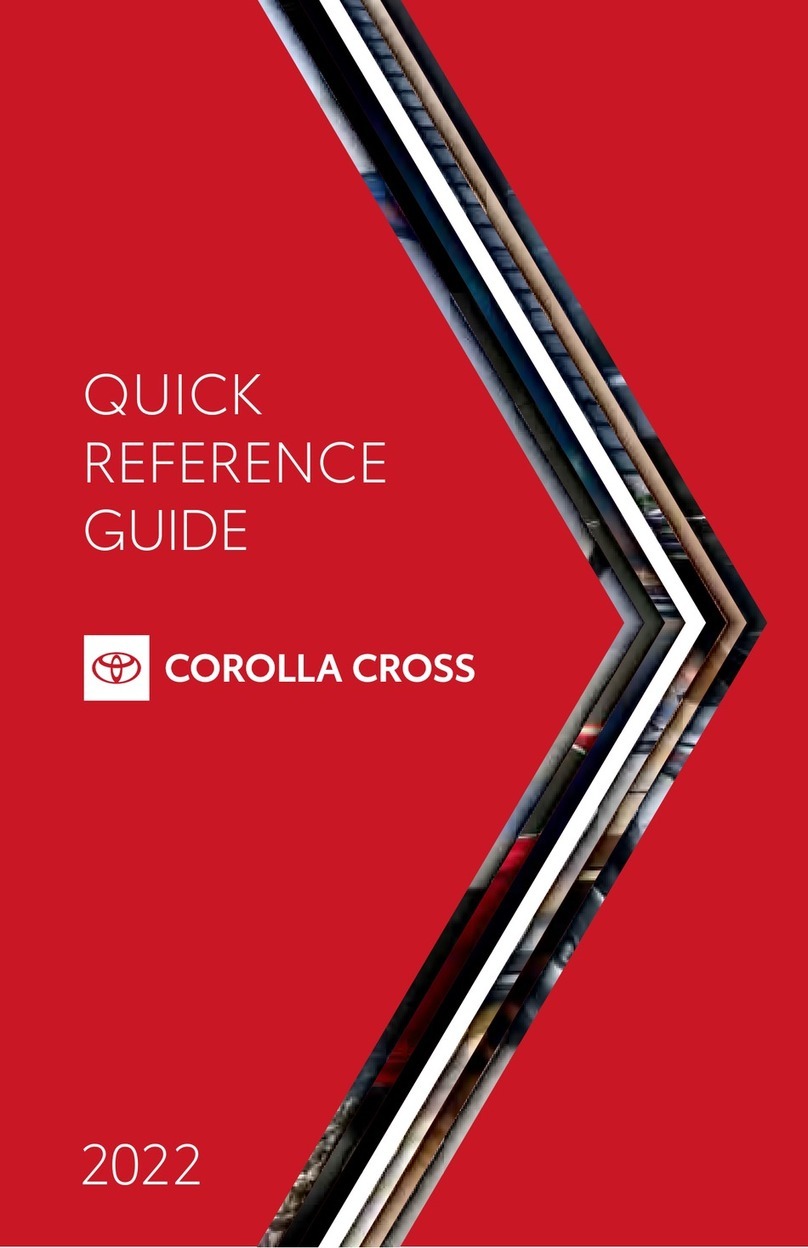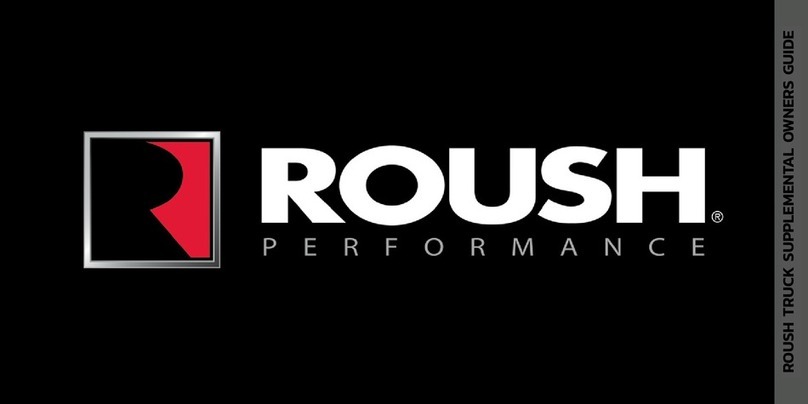Austin SEVEN User manual

I
!
I
==
'i"-
",
HANDBOOK
OF THE
-
"SEVEN"
~
fPUBqCATION No. 1725
PRICE ONE SHILLING.
r.'tHE
AUSTIN MOTOR CO. LTD.
LONGBRIDGE :: BIRMINGHAM
.
~~
J
11
'"
jI
.
,
t1

-;iT
,
,
':S'
'1i%1~
,,
"
>:
HANDBOOK
OF THE
,
"SEVEN" ,>
PRICE -ONE SHILLING
THE AUSTIN MOTOR CO. LTD.
G.P.O. BOX 41
LONGBRIDGE - BIRMINGHAM
T.I.,h"" . PRIORY 2101
Toi.gwm" "SPEEDILY.TELEX. NORTHFlELD"
C"bl,." "SPEEDILY.BIRMINGHAM.ENGLAND" Cod" BENTLEY'S
LONDON SHOWROOMS.
479~483, Oxford Street, W.1.
Tel,ph"".
MAYFAIR 7620 "Tel.gwm"
"AUSTlNETTE. TELEX. LONDON"
AND
HOLLAND PARK HALL
HOLLAND PARK AVENUE, W.ll
Tel"h"",. PARK 8001
RepairandServieeDepotfor "Seven" and"Ten" Cars:-
25, NORTH ROW, LONDON, W.!.
Toi.ph"", MAYFAIR 6211
S.p"mb". 1938 I, "{"",, W of", Book 1725 /
P!eM. quo" {h. "mb"
'""'m," ,"'CA'"
~

-
A .FOREWORD
THEinlormation contained in this Handbook is intended only
to guide and assist the owner or driv~r 01an Austin car to preserve
the car in its proper satislactory running condition. The publi-
cation must not be considered as a complete manual.
... The handbook does not in any manner vary or extend the liability
01 the Company. which is limited to the Warranty jssued with the car.
Where no inlormation is given for a particular adjustment it may be
regarded as one which the average owner would entrust to a garage.
When the occasion for adjustments 01 this character arises the owner
should seek the aid of the local Austin dealer.
Both owner and dealer are encouraged 10call upon IheService Depart-
ment 01 the Company lor advice, whether upon the management of the
car, the eHecting 01 adjustment, or methods 01 repair. Owners need
nol suppose that they will have to apply all the attentions given in this
book, but careful notice should be taken 01 the chapters dealing with
maintenance.
CAUTION,
Parts of genuine Auslin manufacture only should be used when a
replacemenl is made, 10 ensure Ihal Ihe service given by Ihe original
shall be maintained by the replacement. Imilations cannol be relied upon
10 do Ihis.
If imilations are used, Ihe Company's guarantee is infringed and
becomesnull and void.
Always gel your replacemenlsfrom authorised Austin Dealers, as(they
stock only genuine Austin Spare Parts.
Should repairsbeexecuted by other than an authorised Austin Dealer,
for safety's sake always oblain aguarantee Ihat genuine Austin Spare
Paris are used.
See Ihe slalemenl 01 the end of Ihis book with reference 10
Accessories.
In correspondencealways quote your car number; body number will
befound on the scuttle under Ihe bonnet 011the nearside, chassis number on
chassis under the bonnel on offside.
AFTER SALES SERVICE
Every Austin Dealer is under agreement to give to Austin Cars
purchased Irom him "Alter Sales Service" during the period 01 the lirst
1,000 miles running of such <.a(S. (See page 70).
2
CONTENTS
AMMETER READINGS
ATTENTIONS. D.ily, W"kly. M.m,hly. O"",ionolly
BATTERY. The .
BODYWORK. Co" of
BRAKES, Adi""ing. Rdining. ek
BRAKE GEAR. Luh,i,,'ion of
CABRIOLET
CARBURETTER. Adj",'men'. ,le.
CHASSIS LUBRICATION CHART
CLUTCH. Luh,i,,'iou of Mech.ni,m
CLUTCH. Taking up wear
COMBUSTION CHAMBER. CIoanio,
CONTROL OF THE CAR
COOLING SYSTEM
DYNAMO, The
DOOR KEYS
ELECTRICAL EQUIPMENT, The
ENGINE, Lubri,,',on of ..
S'arting,he
.
FAN
FUEL SYSTEM
FUSE. Adion 01,he
GEARBOX,Lub,i",ion of
GREASE GUN. How '0 u" ,he
HOOD (Co" 00 .. ..
HUBS (Fmn' ond Road Luh,i",ion of
IGNITION, Timing
" Sy,'em, The
INFLATING SEAT INTERIORS
LAMPS. Co" of ..
LUBRICANTS. Choi" of
LUBRICATION CHART
PETROL PUMP
REAR AXLE, Lub,i,,',on of
ROAD SPRINGS
RUNNING ADJUSTMENTS
SHOCK ABSORBERS..
SPEEDOMETER DRIVE
STEERING. Adju,'men' of .
STEERING GEAR. Lub,i",ion of
THE NEW CAR
TOOLS
TYRES, Th,
VALVE TAPPETS. Adju,'m,n' 01
WHEEL, Changinga
WIRING. Diagram
~
'. 3
",
'"
PAGE
10,46
14
47
66
54
41
67
22
36 and 37
39
65
58
12
26
44
69
44
36and 37
7
61
20,22
44,51
39
43
66
41
31
28
68
51
34
36 .nd 37
20
40
41
58
64
42
62
40
7
70
16
58
16
'3
.

The Au,tin Seveu de lux. Saloou.
THE AUSTIN SEVEN
THE Austin Seven is acknowledged to be the best small car in the
world.
It is designed lor, and will carry in comlort, lour adults up to a
weight 01 40 stones and 56 Ibs. 01 luggage.
There are live models made, the Cabriolet, the de luxe Saloon, the
Saloon with lixed head, the Tourer and the Two-Seater. The closed
models are alike in general lines and general equipment. Particularly
good leatures are the wide doors and the lour side windowswhich are ~
mechanically raised or lowered.
The large single panel windscreen, which can be opened wide and
secured by an ingenious lever lastening easily reached from the driver's
scat, is another advantage. The Tourer, with its easily operated hood,
and side curtains which open with the doors, provides complete protection
in even the most inclementweather. '
Both Iront seats are separately adjustable. They tilt lorward and allow
ready access to the rear seats or luggage space.
The Austin Seven has a 4-cylinder, water-cooled engine, synchromesh
gears, and bevel drive. Lubrication is by pump, and cooling is on the
thermo-syphon system assisted by lan.
The complete equipment includes electric starting and lighting
switches, loot operated "dip and switch" lor headlamps, air strangler,
electric horn, speedometer, electric windscreen wiper, automatic return
direction indicators, licence bolder, shock absorbers. spare wheel and
4
,
tyre and blank 'number plates. All littings are chromium plated, except
the wheel centres, which are 01 stainless steel.
The Austin Seven is particularly suitable lor the woman driver.
It requires little physical ellort to drive and control, and lor that reason
its use enables her to do shopping calls without latigue, visit her lriends,
attend social and other !unctions, or make excursions or trips in any'
direction in any weather.
For the same reasons business men lind it an excellent vehicle, and
commercial travellers and others whose occupation compels Irequent calls
over an extended area have in the little car an embodiment 01 all they
require. Calls can be made in places where trains, trams and 'buses are
inlrequent.
In large establishments, where the instant use 01 a car is 01 vital
importance in cases 01 emergency, such as sudden illness or accident, the
Seven has been installed as a "tender," and in addition to its superiority
over large unwieldy cars lor short runs, has proved a real time and money
saver.
As40-42miles per gallon is the average petrol consumption, the cost 01
transit is below the cost 01 lares on any public conveyance.
Its speed, economy, reliability and road-holding qualities have been
admitted beyond dispute.
Many thousands of motorists have had their lirst experiences on a
"Seven"; thousands more will lollow them.
Having successlully passed through lilteen years 01 severe use and
trial, it has emerged a really success!ul and popular lavourite and its
splendid qualities are internationally recognized.
"'I The Austin Seven T wo.Seater
5

7~
Th, dim,n,ion, 01 the modd, 'a<y. M.»mum I,ngth 10ft. 7in.
(3,260mm.) Width 4ft.3in.(I,295mm.); H,ight 5ft.3in. (1,600mm.);
Wh,dh.." 6ft. 9in. (2,057mm.); Tm,k, fcont, 3ft.4in. (1.016mm.)
ma<,3ft. 7in. (1,092mm.). wound d,a<.n", 6,in., 61in. .nd 7tin.,
mo,ding to mod,1.
.. Fom.cylindm, w.t".rool,d, with d,tach,hl, hood.
Bo", 2.2in. (56 mm.); Stook"~3in. (76 mm.) ;
Cuhi, """,ity, 7475 cc.. RAC. mting, 7.8.
B"k, ho",.pow", 17.t 3,800 '.p.m.
Ignition, Coi!.
Oil ,i"ul.tion, hy pump: Sump """,ity 4 pin".
Cooling, Th,nno..yphon with film "di.to, .nd Ion. Cooling .y,t,m
"p"ity 10 pint'. Th", i. . 'p,ing Io.d,d "Ivc in top tank to
p,mnt o",lIow hy ,pl"h.
C,onbhafth",ing" Fcont,hall; Cout", pl.in; R"" colI"
THE NEW CAR.
It will Repay YOll to Read these Notes
Carefully.
CHASSIS SPECIFICATIONS
Dimensions..
'"Engin.
Fuol Feed
Start.r
Clutch ..
Gaarbox
Rear Axl.
Spring...
Frout Axle
Brak..
Wbeel. ..
Control.
Ligbting
Bodywork
Luggage
\
IFyou are not familiar with Austin cars
carefully.
Give the new car a general
examination to see that all is in order.
Before running, see the car is
supplied with fuel and water, that the
engine and gearhox have the neces-
sary quantities of oil and that the
battery contains tbe proper amount
of acid.
Cars delivered by road are ready
for running. There is no oil,
fuel or water in cars crated for over-
seas and the batteries are empty and
uncharged.
please read this Handbook
5 gallon(22.75Ii"",) tankat "". Fud ,upply hy A.C. pump.
EI,ct,i",!.
. . Flexihl,,ingl,-pI.t" ,p,ingload,d, the pI.t, ""..,.ing theIdction ,ing..
Fom ,O',d, Io<""d, .nd . 'mm; Th, top, thi,d .nd ",ond g""
hove ,yn,h,om"h ,ng.g,m,nt. which ,n,u'" ,mouth, noi"I""
wt,in g'" ,h.ng" to ,uit "..,.ing ,O',d,. Fi"t g", i. , Iowon'
to h, used in ,tarting with, lulllo.d, up .n indin,. 0' m,noeuvoing
the m in.n .wkw"d pi.". Th, mtio, of ,ngin"o co.d wheel. ""
top,5.125to I; thi,d, 851 to I; soeond,I353to I,.nd fint, 22.4tiii"
,m'", 28.8 to 1. B.II hea,ingsthcoughout.Oil",p"ity Iloin".
.. 1.lIo",ing.withdiff",nti.1.nd 1o<qu,tuh,.
B.1Ih",ings .nd th,.." thcoughout. Fin.1d,ivchy,h,ft .nd 'pi,,1
hm!. Oil cop"ity tpint.
A
j
IA. P,trol Pump Priming Lever.
S.th E. B. DrainPlug.
tartmg e ngme.
Before attempting to start the engine, make sure that the change speed
lever is in neutral position and the hand brake on.
II the car has been standing for some time, starting should he assisted
by using the hand priming lever on the petrol pump to give the carburetteI
a full supply of petrol.
.Give the engine a few turns with the starting handle to make sure that
the crankshaft is free (pushing the handle in to engage fully with the
starting nut, before turning it). The ignition key is turned to the right
to switch on the ignition and the charging and lighting switch is turned
to "High" or "Low" Charge.
t.dlipti, t"nsvcr" ,p,ing in hont.
Qu.rt"dlipti".t "".
Shock .hso,hm .m fitt,d to f,ont ,nd m".
.. . Fo,g,d, I "ction.
.. On.1Ifomwhool,withindividusl,dj..tm,nt.
.. SO'".I wimd,t"h,hl,. On"p", whooIwithtyre. Ty'" 4.00-17,
.nd 4.75-16 (E.L.P.)Dunlop. V.n" 4.00-18.
Th, m""imump"mi"ihI,lo.d fo, the lugg.g,coni" i, 56Ih..
Pull the combined strangler and
throttle control knob on the instru-
ment board to close the carburetter air
inlet, and pttll out the switch to
operate the starter. Be sure to
release the strangler wire after
the engine has started. Do not
allow the engine to race when first
starting up, as time must he allowed
for the oil to circulate and lubricate
various hearings.
B.II ,h.ng, 'p,od g,a<Im" .nd hook, Im"mountod "n",lIy. Foot
rontcol fo, dip .nd ,witch h"dlight,. Foot .,,01,,",00.
.. By g",.d,ivcn dyn,,"o, with 6.volt hatt,..,..
Two hu,k,t "", fo, d,iv" .nd p""ng", hoth h,ing hingodto allow
"'y ,nt"n" to the "" ".t. R", "at to ""y two .dul" 0<thm
,hild"n. Ampl, tool ",ommod.tion. Sp", wh,,1 .nd t}T'. On
toming modd, hood, ,ingl, pi", "",n .nd full ,id, ,croon. (tho"
ov" the doo" open with th,m). EI""i, horn, ,p"dom,'", di"ction
indi"to..., dodri, wind"",n wiO'" d,ivin. mino, .nd li"nce
hold,o.
67
.

'}" .
A
Never leave the ignition switch
on for any lengthy period while the
engine is not running. The warning
lamp on the switch board will remind
you of this.
." Difficulty in Starting.
,Difficulty in starting may he
caused either through 'sucking too
much petrol into the cylinders, or too
little. When starting with the throttle
all but closed, a strong suction takes
effect on the slow running jet. If
petrol is passing through the car-
huretter the suction can generally be
heard.
Str_ler and Throttle Control.
A-No=.l po.I<ion. B-F.., Idlin"
C-W.=in, Up.
If the engine fails to start quickly and it is thought that the mixture
getting into the cylinders may be too rich, the accelerator pedal should be
depressed half-way to reduce the suction. On firing, the engine will race,
and the throttle should be almost closed. If the engine does not fire, close
the throttle entirely, and try again. '
After a stop in hot weather, failure of the engine to start is more
likely to be due to a too rich mixture than one too lean, and one should
switch off only after quite closing tbe throttle. Re-start tbe engine with
the throttle closed.
Depress the clutch pedal before switching on. This ;"ill lessen the
starting load and help the starter to turn the engine at higher speed, as
well as save drain on the batteries.
If after the foregoing measures have been carried out the engine fails
to start, the reason will probably be faulty ignition or carburation.
If faulty ignition is suspected, first examine the wires and see that the
sparking plugs are connected. Then test the gap of the plug points by means'
of the thick end athe gauge provided
in the tool kit. If the points are dirty,
clean them.
If carburation gives trouble, the
slow running jet may be stopped up
or a main jet cboked. Blow them out
orally or with a tyre pump. Never
attempt to clean them by passing a
wire or other small metal object
through tlrem. This will definitely
injure the jets.
The engine should never be
allowed to run at high speeds during
its first 500 miles.
H725.
"Seven" Starting Handle Position.
Oil o""ion.n, " A .nd B.
8
\
Maximum desirable road speeds during the first 500 miles are:-
First gear, 7 m.p.h.: second gear, 11 m.p.h.; third gear, 18 m.p.h. and
top gear, 30 m.p.h.
The Starting Handle (Fixed type).
When the engine is running, see that the starting handle is not hanging
down. It should be replaced in a borizontal position at "9 o'clock."
(See page 8).
There is a catch which will secure it in its proper place there on the
off-sideofthecar. '
The starting handle should be oiled occasionally.
,
2 3 4 5 7 9 .0
60
Au"in "SeveD" Controls.
I. Wind"",n Wip",
2, Ch,ng' Spe,d Lover
3. H,ndbmk, Lover,
4 Dip ,nd Swilcb Con'm!.
5. Clulcb P,d,!.
6. Bmb P,d.!.
7. Accol,mtor P,d,!.
8. Horn Button.
9. Di"ction Indice'or Swi'ch
10.Vi,",
In.trumenr. are lllu.trated ODPage 11.
9
,.
,

rTHE INSTRUMENTS
Fuel and Oil Gauges, Speedometer,
Windscreen Wiper.
A'FULL range 01 instruments is provided on all Austin Cars. They
are 01 the highest quality and the lollowing notes explain their uses,
Fuel Gauge.
The,luel gauge is electrically operated al)d automatically indicates the
approximate contents 01 the tank when the ignition control isswitched on.
When the tank is being relilled, switch 011and stop the engine and
then switch on again and the needle will record the amount 01 spirit
entering the tank. The capacity is live gallons.
The gauge requires no attention.
I
Oil Gauge.
The oil gauge indicates that oil is being pumped through the engine
lubrication system and it should be looked at frequently when the engine
is running to ascertain that sullicient pressure is registered.
When the engine is cold high pressure will be recorded, but this is
likely to drop as the oil becomes warmer. If no pressure is registered the
engine should be stopped and the cause 01the lault ascertained. otherwise
serious damage may be caused.
Flickering 01 the needle may indicate serious shortage 01 oil or a
damaged pipe line.
The gauge may indicate a pressure 0110 Ibs. or more when the engine
is cold or Irom 2 to 10 lbs. when hot. With the engine running at constant
speed the needle should be quite steady.
Windscreen Wiper,
The windscreen wiper is started by pulling out the handle and swinging
it aside to bring the wiper blade into position on the screen. Then move
the switch to the lelt.
On stopping the wiper move the switch to the right and replace the
handle in the top 01 the switch knob so that the blade is held out 01 the
driver's line 01 vision.
.Ammeter.
The ammeter indicates the rate 01discharge 01 the batteries, but does
not indicate current used by the starter motor.
No discharge should be indicated with no electrical equipment in
use or with headlamps on when the car is running at about 20 miles an
hour (30 kms.), or laster.
I
[
10
~
-- ~--- -..,
"
Switch Box.
When the engine is not'in use the ignition key should be withdrawn
Irom the switchbox. It can be withdrawn only when the ignition is "off."
The lighting switch also controls the rate at which the dynamo charges
the battery. "High Charge" should be used in the Winter and when the
car is used very little in the Summer. "Low Charge" is lor Summer use
when the batteries are not used a lot lor lighting, or frequent starting. and
the car is used fairly frequently.
Speedometer.
The figures on the speedometer record up to 100,000 miles or kilo.
metres and they automatically return io zero.
The flexible shaft of the speedometer drive from the gearbox should be
lubricated by oiling from the speedometer end every 2.000miles. To do
this uncouple the union nut behind the speedometer.
The shafting should also be taken down and thoroughly cleaned every
6.000miles. It should be lubricated along its length by applying thin
grease so that when the shaft is replaced in its tubing there will be a good
supply of lubricant.
Grease should also be smeared round the flange where it rubs the
washer of the key piece wh:ch connects to the speedometer.
Traflic Signals.
The trallic indicators are con.
trolled lrom the steering wheel.
Normally. after the car has turned a
corner they automatically return. but
when a slight turn has been made it
may be necessary to switch olf.
Panel Lights.
The instruments are illumin.
ated by two lamps controlled by the
same switch. The holders can be
swung aside to facilitate removal of
the bulbs. whichin emergencycan
belitted to the side or combinedstop
and tail lamp.
Dip Switch.
The headlamp dipping switch has two lunctions, one to give the
normal driving light and one to dip the near side head.lamp beam and at
the same time switch 011 the ollside headlamp.
If the headlights are on lull, a touch 01 the loot on the switch alters
the lamps to the "dip.and.switch" position and they remain so until
another touch returns them to the "lull on" position.
Continental headlamps have dual.filament bulbs and are dipped
in the same manner.
Windscreen.
The windscreen is opened by lifting the handle and pushing it lorward.
.
.
Tb. Im.rumen. PtmeI.
A-S'nn,L". F-W.rnln, L.mp.
B-oil G.u". o-I,nl<lon K.,.
C-Amm"... H-LI,h' Sw""'.
D-D..h L.mp Swl«h. 1- Fu.I G.u,..
E-Sp..dom"", ]-5,..", ConttoL
!I
J

.,.
,
CONTROL OF THE CAR
How to Change Gear; Some Good
Driving Hints
THE driving seat 01 the Austin Seven is adjustable lor position and
tbis convenience sbould be taken advantage 01 to obtain tbe greatest
comlort.
To engage lirst gear, pusb out the clutcb and move tbe gear lever
into tbe lirst speed position. .
Sometimes it may bappen tbat wben tbe clutch is let in, tbere
is no apparent drive Irom tbe engine. Tbat is because tbere bas been no
proper engagement 01 tb, gears. Tberelore, pusb out tbe clutcb again,
and it will almost certainly be lound tbat tbe lever can then be moved
so as to give tbe proper gear engagement witbout using any lorce.
Start on'lirst speed, accelerate to about 8 m.p.b., pusb out tbe clutcb,
move tbe lever to neutral, and continue tbe movement 01 the lever steadily
to tbe second speed position and let in tbe clutcb gently. '
In moving from second to tbird speed, a similar action takes place.
Accelerate to about 18 m.p.b., declutcb, release tbe accelerator, move tbe
lever to neutral and continue tbe movement 01 tbe lever steadily into tbe
tbird speed.
To move from tbird to top, declutch, and move tbe lever steadily
into tbe position desired. It assists tbe cbange Irom top to third, and
tbird to second il tbe accelerator is held down while the change is made.
I
I
.
Change Early.
Always change gear early on a bill. Never allow tbe engine to labour
in any gear and expect it to pick up speed on changing into a lower one
wben the car has nearly stopped. Do not persist in attempting to drive
the car uphill in top gear wben the speed lalls below 18 m.p.h.-cbange
down.
If the car bas been driven back by tbe reverse gear, wait until it is
stationary belore engaging a lorward speed. Do not engage the reverse
gear when the car is travelling lorward. Serious damage to the gears will
be the result.
Keep the loot 011the clutch pedal
except in heavy trallic. Even then
do not allow tbe weight 01the loot to
be taken by tbe pedal. Tbe slipping
01the clutcb caused by tbis practice
beats and wears it badly.
When descending a long bill, or
before commencing a steep descent,
engage one 01 the lower gears, and
do not accelerate. The Gear Positi...,.
12
\
~
The engine will tb~n belp to retard the speed 01 tbe car. When
using the brake, keep tbe clutcb in, disengaging it at the last moment il
.topping tbe car.
Skidding.
Skidding is sometimes due to sudden braking on a greasy or loose
surlace and unduly slack tyres contribute to it. If the rear wheels skid,
release the brakes and turn the Iront wbeels towards the direction 01
the skid.
Synchromesh Gears.
Tbe gearbox bas lour lorward speeds and a reverse and the second
third and top gears have synchromesh engagement, which ensures silent
positive cbanges.
Cear cbanging may be sligbtly still in a new car until tbe moving
parts bave eased in use. Cbanging sbould not be done burriedly and
no attempt sbould be made to lorce tbe gear lever il engagement is not
made at tbe lirst attempt. Sbould
dilliculty be experienced in en-
gaging a gear wben tbe car is
.tanding, release tbe clutcb lor a
moment and tben try again.
Tbe syncbromesb mecbanism
is governed by a series 01 spring fQtt:',:
loaded balls as illustrated. Tbe
internal cone on tbe inner member
makes contact witb tbe gear
mne to syncbronise tbe speeds 01
botb members belore tbe dog
member, overcoming tbe resist-
ance 01 tbe ball A. moves on to
give positive gear engagement.
What Not to Do.
I
Second Speed Synchroni,ing Mecl.anism
A. Spring Ball Re,iotance.
Whatever you do, please do not make tbe lollowing mistakes :-
Do not lorget tbe ignition switcb wben starting up.
Do not make a last run witb tbe radiator mull closed.
Do not be cruel to tbe starter il tbe engine will not lire.
Do not toucb tbe starter switcb wbile a gear is engaged.
Do not leave tbe car in gear and witb tbe bandbrake 011.
Do not coast witb a gear engaged and tbe clutcb beld out.
Do not lill tbe radiator witb cold water wben tbe engine is bot.
Do not leave tbe ignition switcbed on wben tbe car is not running.
On no account run tbe engine in a closed garage. Tbe exbaust gasses
are bigbly toxic and a very small amount in a restricted atmospbere
will produce grave, il not latal results.
13
,

"I
REGULAR ATTENTIONS Monthly Attentions.
ON this and the opposite page is a handy summary of all theattentions
descrihed in this handbook. The attentions under the daily,
weekly, and monthly headings are based on the assumption that the
maximum mileage per week does not exceed 500.
Under more strenuous conditions, for instance, very dusty or very
muddy roads, long distances at high speeds or with heavy loads, It wIll be
advisable to attend to the lubrication of chassis parts more frequently.
After the first few days" use tighten all nuts particularly those on
the engirle cylinder head. These may loosen a little because of the heat
generated, but if they receive this attention both they and the head will
remain !lecure against water leaks or loss of compression.
Waming.-After the car has been washed, or driven through water.
the hrake linings may be wet. Apply the brakes a number of times for
some distance in order to dry them.
Wet brakes are dangerous.'
Daily Attentions.
I.
I. Examine the oil level in the
gearbox. It should be level
with the filler plug. Capacity,
It pints.
Change at first 1000 and
then every 6,000 miles.
2. Charge the back axle case with
special lubricant, using the
adapter on the grease gun.
Capacity fpint. .
Change at first 1000 and then
every 6000miles.
3. Grease all the hubs, as des- The Gearbox Oil Filler.
scribed later.
4. Charge the steering box with special lubricant,
5. Oil handbrake gear, pedal gear and joints, engine control joints, and
top of steering column.
6. Examine the battery and see that the connections are tight. (More
frequently in hot weather).
7. Give a charge of the special grease to the nipple on the fan spindle.
8, Give a few drops of oil to the distributor spindle bearing.
9. Grease the front end of the torque tube (behind the front seats).
10. Grease the splined end of the propeller shaft (behind the gear box)
Turn the shaft to expose the nipple.
11. Grease rear brake balance lever,
Examine water level in radi- .
ator and fill up to within one
inch of the top.
2. Examine oil level in the crank-
case and add more oil if
necessary. The dip rod indi-
cates the level of the oil.
Change the oil first at
500 miles, then every 2,000 to
3,000 miles (3,200 to 4,800
km), when the oil reservoir
gauze should be cleaned. The
sump capacity is half a gallon,
3. Fill up' the petrol tank if necessary. Care should be exer-
cised not to overfill the tank, which will contain five gallons.
Weekly Attentions,
I. With the grease gun charge-
Front spring shackle pins (4).
Front wheel swivel pins (2).
Steering cross tube (2).
Steering side tube joints (2).
Rear spring pins (2).
2. Oil the following-
Clutch release ring.
Foot brake pedal shaft (below steering box),
Brake cross shaft bearings (use a brush).
3, Examine both sets of brakes, and adjust if necessary.
4. Test the tyres for correct pressure and examine them for cuts, flints
and nails.
Occasional Attentions.
Clean the sparking plugs and check the settings.
Examine all bolts and nuts, such as road spring dips, cylinder head
nuts, wheel nuts, these three especially when the car is new.
Examine other parts, such as steering connections, the radius rod
JUlchoragebelow the gearbox, and the torque tube socket, neglect of which
might be followed by an expensive repair and inability to use the car for
.a lengthy period.
Occasionally dean the pump and carburetter petrol filters and float
-chamber strainers, and ever 2,000 to 3,000 miles the oil reservoir gauze
(when the engine oil is changed). Also ensure that the oil jets in the
-crankcase are dean.
Flush the radiator with plenty of dean water until it runs through dear.
Clean the ignition distributor, and the contact breaker points (adjust the
latter), the dynamo and starter commutators. Clean the shock absorbers.
.adjust the tappets, and the fan belt, decarbonize the engine and grind-in
the valves. Check the alignment of the front wheels.
D.e only recommended Oil..
14 15
" 4

-..-
WHEELS AND TYRES.
How to use the Jack; Correct Inflation
Pressures
WHENit becomes necessary t6 change a wheel hecause of a puncture
or for any other cause. the firstthing to do is to pull the handbrake
"hard on." The spare wheel must be lifted from the rear of the car.
Before it is used test the air pressure and if it is not up to the correct
figure. use the pump to rectify it. The proper pressures are tabulated
on the next page.
It is important~ have the car on
level ground. With the wheel brace
the three nuts of the wheel to be
removed should be slightly slackened.
but only enough for them to unscrew
freely later. The wheel is tb'en
jacked up.
If it is a rear wheel. the jack
should be put in from the'side, be-
tween the mudwing and the forward
edge of the.tyre, and should be placed
under the rear spring between the two
clips which embrace the spring leaves.
If a froni wheel is to be attended
to, first slacken the nuts by means of
the wheelbrace. Place the jack under
the front axle neaf but not under the
big nut at the end.
The operating bar (which is
stored under the rear seat cushion)
fits into the jack by means of a
square tube and 15secured in that position by a spring loaded ball.
The head of this bar which
engages with the jack must be
pushed well home so that a spring
loaded ball may engage with a slot,
which will prevent the head of the
bar slipping out while the jack is in
use.
The jack should be adjusted as
nearly as possible to the required
height by turning the head round by
hand before using the handle to lift
the car.
To detach the wheel from the
hub remove the three nuts by
H' ",.
How to use the Jack
on the "Seven."
~"".
".'
The Jack, .howing Extension 16
""'..
.-1,
,
means of the brace; on some models,
including vans. it is not necessary to
remove them entirely. Pull the wheel
outwards about tin. and turn it a
little to the left so that the large hole
will pass over the nut. The wheel can
now be pulled off the hub.
When replacing these slotted
hubs, make sure that the large holes
in the wheel centre are properly fitted
over their pegs, and tighten the wheel
nuts, each only a few turns at a time,
until they are quite tight and secure.
Should difficulty b" experienced
upon the first occasion of removing
the wheel from the hub. the wheel
nuts may be screwed right off. Before
replacing, wipe the outside of the brake drum and inside of the hub
with an oily rag as this will ease removal on future occasions.
". .,
Do not detach nut.. The wheel
will.lide over them.
Care of The Tyres.
The key to economical and efficient tyre service is to maintain the
correct pressures and test your tyres at least weekly. Any loss of air
pressure can be made up with very little effort.
A gauge applied to the valve must be used, for it is seldom possible
to detect under-inflation from the tyres' appearance.
Minimum presssures to which tyres should be inflated are :-
I
I
Atyre that loses more than three to four Ibs. per sq. inch in a week
should be regarded as "suspect." First, make sure that a new valve
"inside" is not required. If the tube is punctured make sure before refitting
that the puncturing object is not still embedded in the cover.
It is important that both front tyres be kept at same pressure. If
because of wear or other causes. the steering develops a tendency to wander
or show signs of wobble, the front tyre pressure may temporarily be varied.
17
....
Rear Tyres.
Tyre Size. Front
Tyres. One or two Fully
Passengers. Laden.
4.00-17 (Standard) 22 22 26
4.75-16 (E.L.P.) 20 18 22
4.00-18 (Van) 22 -26
4.75-16 (Van) 24 -26
Lbs. per sq. in.

Dirty Tyres.
Oil. paraffin and grease are in-
jurious to rubber. and should be
removed as soon as possible by the
use of a clean cloth and a very little
petrol.
Cuts and Damage.
Damage affecting only the rubber
tread and walls may be plugged with
a good tread cut filling. If this is done.
promptly an extension of the injury T.ght.n the wheel nuts alternatdy
.11 bd.. and ..cur.ly.
Wl e prevente .
Damage of a more serious nature affecting the collon structure should
be entrusted only to an expert tyre repairer or the tyre manu~acturer.
It is essential that the tyre be removed immediately the damage i.
lustained.
Fitting Hints.
When refitting a tyre attention is called to the following points.
To avoid trapping the tube between the edge of the cover and the
rim, always inflate the tube very slightly before placing it in the cover.
During the final inflation see that the edges of the cover are seated
evenly round the edge of the rim. Check this by the moulded line on
the cover. which should be about a quarter of an inch from the rim all
the way round.
Covers are marked with a red spot near the wire edge. This indicates
the lightest part, which should be fitted immediately over the valve.
Uneven Wear.
Becausethe front wheelsare
~II
11'
Wipe th. inside of th. wheel with
an oily rag.
\--
..cambered," or lean outwards, the
outer side of the tyre tread wean
more than the inner .To minimise
the effect of such wear, turn the tyres,
say every three or four tousand miles,
so that the more worn sides are next
to the car.
At the same time, exchange the
near and offside tyres so that the
unequal weight distribution and
consequent wear caused by road
camber are shared.
If the front tyres begin to wear
rapidly, have the tracking of the front
wheels checked immediately and, if
necessary, adjusted.
18
- - -- -- ...
I
:::
u
:> '"'
u .~
V) c:
c:P
.~
'"' ....
'" "
=' ~
~ 0
" ~
..<::
I-< I
19
-J

THE PETROL PUMP.
How Fuel is supplied from the Tank to
the Carburetter
,
PETROL is drawn from the tank at the rear'by means 01 an A.C.
petrol pump which advances the Inel in the correct quantity demanded .
by the carburetter, no more and no less.
Service on the petrol pump is available at all Austin Dealers and at all
A.C. service stations, which are prepared with parts and lixtures lor
repairing and adjusting all pumps il any trouble is experienced with the
Inel supply.
Make sure that any dilliculty is not due to causes apart Irom the
pump belore attempting to do anything to the pump.
11there appears to be lack ollnel at the carburetter. lirst ascertain
if there is any Inel in the tank, and il not. replenish. Make sure that the
pipe and connections between the tank and the pump, and between ,the
pump and the carhuretter, are not leaking. In case 01 broken or damaged
piping replacement should be made.
lt may be that the litter cover of the petrol pump is loose. 11this is
the case, tighten the main nut at the top, lirst ascertaining that the cork
gasket lies lIat in its seat and is not broken or unduly compressed. A
gasket compressed hard may need to be replaced.
Clean the Filter.
Occasionally remove the cover and dean the lilter screen underneath it.
Also remove any sediment Irom the chamher below the lilt er by taking out
the drain plug (F.) Make sure that the libre washer is under the head 01th.
plug belore replacing.
When re-assembling, take care that the cork gasket is replaced correctly,
under the cover, and that the libre washer is under the head 01the screw.
11petrol appears to be leaking at the edge 01 the diaphragm tighten
the cover screws alternately and securely, but do not attempt to dismantle
the pump body.
Sometimes there appears to be a leakage 01 luel at the diaphragm
joint. The leakage may actually exist at one 01 the pipe littings, causi~g
the Inel to run down the pump on to the diaphragm lIange.
In hot weather when petrol is likely to evaporate, or when dilliculty
might be expected on cold mornings, it is advisable to lilI the carburetter
by operating the hand priming lever on the pump before attempting to
start the engine. lt will be appreciated that il the engine comes to rest
when the rocker arm is on the high point 01 the eccentric the priming lever
will be inoperative. In the event 01 this the engine should be turned
over one revolution by hand.
The pumping action 01 the diaphragm can be distinctly lelt until
the carburetter bowl is lull.
Alter removal 01the upper casting on any type 01A.C. Inel pump it is
important that the cover should only be replaced while the pump pull rod
20
I.
-
~
I
11
!
I
I
I
i
!
i
I
+
..
;to.
--~ '"'"
is at the top 01its stroke. This is to ensuresullicient lIexing01the dia.
phragm to allow its normal working movement.
How it works.
By revolvingshalt (P) the eccentric(0) will jilt rockerarm (Q) which
is pivoted at (S) and which pulls the pull rod (K), together with the
diaphragm(H), downwardagainstthe spring pressure U), thus creatinga
vacuumin the pump chamber(C).
Fuellrom the rear tank will enter at (D) into sediment chamber(E)
and through the lilter gauze(A)and suctionvalve(M) into pumpchamber
E
F
GI
H
J
K
,
The A.C. Fuel Pump.
F-D"'n PI",. L-Prim'n, lm..
(C). On the return stroke spring pressure U)pushes the diaphragm (H)
upward, lorcing the luel Irom chamber (C) through pressure valve (C)
and opening (B) into the carburetter.
When the carburetter bowl is lilled the lloat in the lloat chamber will
shut 011the inlet needle valve, thus creating a pressure in pump chamber
(G). This pressure will hold diaphragm (H) downward against the spring
pressure U)and it willremainin this positionuntil the carburetterrequires
lurther Inel and the needle valve opens.
The rocker arm (Q) is in two pieces, the outer one operating the inner
by making contact at (R) and the movement 01the eccentric (0) is absorbed
by the "break" when Inel is not required.
Spring (N) is merely lor the purpose 01 keeping the rocker arm (Q)
in constant contact with the eccentric (0) to eliminate noise.
21
.J

...,..-
ZENITH CARBURETTER
Cleaning and Adjustment for good
Performance
THE carburetter fitted to the Austin Seven is the Zenith "V" type,
embodying the well known principles, of main and compensating
jets.
Pelrol from the pump passes through the union, the filter and the
needle seating into the float chamber. As the float rises it will close the
needle on its seating, thus regulating the flow of the petrol.
The float chamber contains the main jet, the compensating jet, the
capacity well, and the slow running jet. Petrol flows through the main
and compensating jets and also rises in the capacity well. From the jets
it flows along two separate channels into a common channel in {he emulsion
block attached to the float chamber. This main channel has its outlet
in a nozzle which projects into the choketube.
Tbe capacity well is in direct communication with the atmosphere,
and the compensating channel in the emulsion block.
I,
!
I:
Starting the Engine.
To obtain an easy start from cold the combined throttle and strangler
control on the dashboard should be extended to its third position, and the
engine should be given, by hand, a few turns to free the working parts.
Then pull the self-starter control knob and when the engine is running
release the strangler control to the first notch.
In cold weather it may be, necessary to hold the strangler control
out for a few minutes while the engine warms up, and to run the car for
the first few minutes with the knob in the first notch, As soon as the
engine is warm, however, the control knob should be pushed right in,
otherwise the mixture will be too rich.
If difficulty in starting the engine is experienced, ascertain that the
strangler flap is closing properly and if necessary adjust the wire.
A choked slow running jet will also cause difficulty. The jet should
be cleaned only by blowing through it, either with a tyre pump or orally.
Trouble can also be experienced if the throttle is not open sufficiently
when the strangler knob ,on the dash is in the first notch. In this case
turn the adjusting screw a little to the right to open the throttle wider. '
If the engine does not idle as slowly as desired, turn the screw to the
left to close the throttle slightly,
ii 22
.,
A weak mixture may cause difficulty in slow running and this may be
adjusted by turning the regulating screw clockwise to enrich the mixture,
Do not make the mixture too rich or the engine will "hunt," or will tend
to choke when slow running while warm,
Adjustments.
No adjustments should be carried out unless absolutely necessary.
If the engine is positively poor in accelerating when it is running at a
sufficiently warm temperature, and the adjustments described will not
remedy the trouble, it may be desirable to fit a larger compensating jet.
,I
The V Type Carburetter (without Air.Cleaner).
A-Pmol Union
B-Union Nm
C-W"h",
D-Rm,ning Bol"
E-Adjo."n, Smw
F-R"olo"ng Smw
If there is a lack of power and speed, this may be due to the main jet
being partially choked, or if greater power is desired a larger size rrlliin jet
may be fitted.
Make sure that the strangler flap opens fully, for if this sticks in a
partially closed position it will restrict the speed of the car and increase
petrol consumption.
Do not, however, alter the jets unless you are quite sure that other
parts of the engine, including sparking plugs, ignition and valves are in
order, and that compression is good. There are no moving parts in the
Zenith carburetter, so that nothing can get out of adjustroent when once
set.
23
c
11-
I
I
I
.i
A

~~
1'[
"'
111.
1
1,.,
Clc"";ing.
The bowl 01 the carburetter should be removed occasionally ./or
cleaning. Take out the two retaining bolts and the bowl will drop
into the hand. On turning the bowl upside down the float willlall ,outand
reveal the main and compensating jets at the bottom 01 the bowl.
7
I
~
'I'
312
The Carburetter Bowl.
l M.in '0<
3 C.",i" w.ll
5 Emul.lon blo,'
7 Rminin, bol<.
2 Com,.n.."n, ,0<
4 Slow.ronn'n, '0<
6 Non>.
8 Squm .nd '" 10= '0< «v.
j
The jets are removed hy litting into them the squared end alone 01
the retaining bolts and using a spanner on the other end. To clean
the jets wash them in petrol, and blow through them to remove obstruction.
Do not me wire.
The connection Irom the petrol pump should be dismantled and the
filter thoroughly cleaned in petrol. When reassembling take care that the
washers on either side 01 the union are correctly replaced. :t
,
24
"
Standard Settings.
Sizes 01 Zenith jets normally run in 5's-the higher the number the
larger the jet.
Settings are likely to be varied to suit certain markets. Standard
settings are :- Choke
Main Jet. oo
Compensating Jet...
Slow-running Jet .oo
Progression Jet
Needle Seating
Capacity Tube
17
57
50
60
50
1.5mm.
2
"Leaded" Fuels,
Provided that the same reasonahle attention is given to the valves and
other adjustments as with ordinary petrol there will be no trouble when
using "leaded" fuel (petrol containing a small proportion 01 tetraethyl
lead). '
The appearance 01 the valves when running on "leaded" fuel dillers
Irom that associated with ordinary petrol but this is a well recognised lact
to which no signilicance should be attached.
The deposit from such fuels can be removed by "scrubbing" the
valves and their seats with a still wire brush 01 the type used lor cleaning
liles (a "Iile card"), alter which the valves can he ground-in in the normal
manner.
We would recommend this method 01cleaning lor all valves, whether
they have operated with leaded or ordinary fuels, as it eliminates the
possibility 01 leaving small amounts 01 deposit on the valve seats which
tend to cause damage or prolong the "grinding-in" process.
Air Cleaner.
On export models an oil wetted air cleaner is litted to the carburetter.
At Irequent intervals, say weekly in countries where dust is constantly
experienced, the silencer needs cleaning and re-oiling. It is taken 011
the carburetter by undoing two nuts and it should be swilled in a shallow
pan 01 petrol.
After drying, the metal gauze mesh should be re-oiled with engine oil,
allowing the surplus to drain 011belore relitting the cleaner.
11the air cleaner is neglected it becomes choked with dirt, so that the
cleaning elliciency of the device and its valuable protection against engine
wear are not maintained.
25
I
I'
11
11
11
I
li /
!
J
ijl

THE COOLING SYSTEM.
Precautions to take against Freezing and
Overheating
THE cooling of the engine is maintained by a capacious radiator which
should be filled with rain water if available, up to within about
onc inch of the top of the filler. The capacity of the radiator.
pipes and cylinder jackets is 9-10pints.
In Winter an anti-freezing
mixture should be added to the water
in the radiator, because in very
severe weather the water may freeze
and thus damage the cylinder block
or the radiator itself. Moreover,
when an anti-freeze mixture is used,
there is no need to draw off the water The Water Level,
to prevent damage by frost, A-M"imum. B-Mioimum.
There is a spring-loaded valve in the top tank of the radiator to prevent
overflow by splash, When emptying the system the filler cap must be
removed or an air lock may prevent complete drainage. This must be
particularly remembered in frosty weather,
Smith's "Bluecol" and Price's "Zero" are suitable.
If such a mixture is not used, care should be taken to see that the water
is drained off completely, for, in case of freezing, it will do harm by lodging
in small spaces, and fracture of the cylinder block may result. In Great
Britain the climate does not very often call for the cooling system to be
drained, but it is well to err on the right side and take due precaution
against damage if frost be threatened.
I;
Kc
Freezing.
In frosty weather freezing may occur first at the bottom of the radiator
or in the lower hose connection. It is sometimes possible to fed ice in the
hOle and break it by squeezing.
Ice in this hose will stop water circulation and may cause boiling.
Before using anti-freeze mixture tighten the cylinder-head nuts to
make sure that none of the mixr.ure gets into the cylinders. The mixture
may do considerable damage if it contaminates the engine oil.
11.
I'
Flushing.
To prevent the gradual formation of deposits in the cooling system
with consequent impeding of the circulation, the use of hard water should
be avoided. Soft water. rain-water (syphoned from the top of the barrel
where it isclean) or, failing that, water that has been boiled, should be used.
26
l'
,.
.
!
-
~
Occasionally flush out the water cooling system by opening the drain
cock at the bottom of the radiator and allowing water to run through until
it comes out clear.
Causes of Overheating.
Overheating may be attributed to onc or more of the following causes :-
Slack fan belt. The belt can be tightened by turning the fan spindle
in its bracket after loosening the clamping-nut,
Excessive carbon deposit in cylinders. See "Running Adjustments"
Running with ignition too far retarded. (See page 31.)
Using oil of poor quality, or lack of oil in the reservoir. Se.
"Engine Lubrication."
Partial choking of the oil jets. See "Engine Lubrication."
Improper carburetter adjustment, giving a mixture too rich or too
weak. See "The Carburetter."
Failure of water to circulate, because of choked radiator, water
level below the tops of the radiator tubes, or loss of water through
leakage from connections.
Overcooling is almost as bad as overheating,
too cool, use a radiator muff.
Trouble arising from a damaged radiator
dismantling and despatch to a repair depot.
If the engine tends to be
generally necessitates its
Be .ure tbe
road it clear
before opeuU,g
a door.
I \
\ \\
27
I

THE IGNITION SYSTEM
Cleaning the Distributor; Lubrication
Fault Finding
11
THE C,illgnition Equipment is provided with an automati.c advance
mechanism, which relieves the driver of the necessity of constant
adiustment of the hand ignition controL Its advantages are par-
ticularly evident when accelerating, and during hill climbing, the danger
of pre-ignition, knocking or "pinking" being very much reduced.
The device is housed in the distributor body and it consists of a
;entrilugally operated mechanism by means of which the ignition is
advanced in proportion to the engine speed. .
Very little attention is needed to keep the ignition equipment in
first-class condition; we advise that it is inspected occasionally and the
following instructions on lubrication, cleaning and adjustment should be
carried out.
I
The Contacts,
11
E
:1 Di,tributor and Contact Breaker.
I" A EI",rod..
B Cubon BMh.
C Con"'"
D Lo,ki.. Smw.
E Row'n, C,rn
FM.", EI.mod..
G Row'n, d",ribu,o, .=
H Cond.no".
J Con"" bmk" plvp,
28
~\
I"
1:
"
The Distributor,
The distributor cover can be removed on springing aside its two
securing clips. The electrodes "A" and "F" and the inside of the cover
are then accessible for cleaning with a dry duster. See that the carbon
brush "B" is clean and moves freely in its holder.
After the first 500 miles running it is usual for the car to be taken to a
service station to have various minor adjustments made to the engine.
As most of the bedding down of the contact breaker heel occurs during this
period the gap between the contacts must be checked and if necessary,
re-set to give a maximum opening of .012 ins.
After this, the gap between the contacts will not require adjustment
until a considerable mileage has been covered, unless the contacts have
burned. The work of re-setting the contacts when this has occurred,
should be left to a skilled mechanic. For the normal adjustment, first turn
the engine by the starting handle until the contacts are seen to be fully open.
. Then, using the ignition screwdriver, slacken the two screws "D" in the
contact plate, and move the plate until the gap is set to the thickness of the
gauge. After making the adjustment care must be taken to tighten the
locking screws.
The CoiL
The coil needs no attention apart from keeping the terminals tight
and the top clean.
Ignition Switch and Warning Lamp.
The key, by means of which the ignition is switched on. should be
withdrawn when the engine is not running. This will ensure that the
battery does not discharge by the current continuing to flow through the
coil windings.
The warning lamp on the instrument panel will light when the
ignition is switched on and the engine is running slowly or is stationary.
Should the bulb of the warning lamp fail this will not affect the ignition,
but it should be replaced as soon as possible so as to act as a safeguard to
the battery. It can be removed from its socket when the small cover plate
holding the red glass is unscrewed. The replacement bulb should be a
2.5 volt 5 wat' screw cap type (Lucas No. C252A) as originally fitted.
Lubrication.
The distributor spindle bearing is lubricated by means of an oiler
which needs a few drops of thin machine oil every 1,000 miles.
Every 3,000 miles give the cam
and also the pivot "r on which the
contact breaker works, a smear of
Mobilgrease No. 2. Withdraw the
rotating arm "C" from the top of the ~
Ignition Screwdriver and Gauge
29
,

--;>
~spindle by lifting it off and add a few drops of thin oil to the top of .the
spindle. Do not remove the screw exposed to view, as tbere is a clearance
between the screw and the inner face of the spindle tbrough which the oil
passes to luhricate tbe cam bearing. Take care to refit the arm correctly and
to push it on to the shaft as far as possihle.
The moving parts of tbe automatic timing control must he lubricated
with a good grade thin engine oil. To render the control accessible,
remove the distributor moulding and lift off the rotating distributor arm.
Then remove the contact hreaker moulding by withdrawing its two
securing screws. Take care to refit the contact hreaker moulding in its
original position. .
11
11
High Tension Leads.
If the high tension cables show signs of perishing or crackmg, they
must be replaced. Use only 7 m.m. rubber covered ignition cable for all
higb tension leads.
To make a connection to tbe distributor or coil terminals. thread
the knurled insulating nut over the lead, bare the end of the cable for about
1of an inch, thread tbe wire tbrough the hrass washer provided, and bend
back .trand" When the moulded nut is screwed home, the cable will be
.ecurely clamped, and the nut will support the cable, and prevent vibration
and fracture.
il
il~i
Ignition Faults.
If the engine will not fi<e, or fires erratically, the trouhle may arise
from the carhuretter, or petrol supply.and not the igniton. A partially
choked jet, an incorrect petrol level, or air leaks into the induction
system may be tbe faults. Equally, sooted plugs can be suspected, when
dismantling and cleaning them will
remedy the trouble. If the batteries
have run down, or the terminals have
worked loose, quite obviously there
will be no spark, and the same results
can be expected if the distributor
electrodes and contact hreaker have
been neglected and are dirty.
The coil can be tested by re-
moving the cable from the centre
socket on the distributor cover, and
holding the end of this cable ahout
1inch from some metal part of the
car while the ignition switch is on and
the engine is turned. A strong and
regular spark will result if the coil is
in order. Clean the top of the coil
A-H.T. C,bl, B-Mould,dT,=io,l and ensure thatit~ terminals are tight
C-Wuh" D-C,bl, S,mod. before making thIS test.
Ii
D
I
cH
'!"
I
111
,'"
I:j~ c
,~~
,." High Temion Terminal.
il
,
'
'I
"
:, 30
l
B;
I
po'
I
'i.
I
il,
"
.
i
'j
,
Short Circuits.
To test for short circuits in the
Iow tension wiring (the cables from
the switcbboard to the coil, and coil .
to distributor) which would equally
cause irregular running, have the
engine turned while the ignition is
switched on, and watch the ammeter
reading. It should rise and fall as
the contact breaker points close and
open.
This test will also indicate if
the contact breaker is functioning
correctly. If the contacts rcmain
open or do not fully close, the read-
ing will not fluctuate.
I. . I f A..,mbl",mo"d<O"'O".u<om"',"m'o,.
f the high tension cab es ram
the distributor to the plugs are not
.ecurely attached to the distributor, misfiring may occur. Or, if the
rubber insulation on these cables shows signs of perishing and cracking,
there may be leakage of the current giving rise to the same symptom..
Renewing the cables is then the remedy.
If, after verifying the,e points, the trouble remains undiscovered
the equipment should be examined and tested by the nearest service
depot of the makers.
Contact Breaker.
Timing the Ignition.
As it is essential that a spark should occur at the plug points as each
piston reaches the top of its compression stroke, re-timing after dismantling
needs care, but should present no difficulty.
In order to reset the ignition timing remove all sparking plugs excepi
No. I and, using the starting handle, turn the crankshaft until No. I piston
is at top dead centre before a firing stroke. The compression felt at the
handle will denote the correct stroke. Watch the valves, too, as on the
firing stroke both inlet and exhaust valves will be firmly seated. Top dead
centre No. I piston is also marked on the flywheel (1/4), which can be seen
after removing the clutch pit cover (see illustration on page 39), but actually
it is necessary for the ignition to occur somewhat earlier. Therefore turn
the flywheel back about t.in. (12 mm..). Remove the distributor cover,
slacken the screw in the clip of the distributor casing and turn the casing
until the contact breaker points just hegin to open, with the rotating centre
arm pointing to the position of No. I electrode in the distributor cover.
Tbe spark is then correctly timed for No. I cylinder, and of course, for
Nos. 2, 3 and 4.
31

fAs the distributor cover carries the electrodes for the four cylinders, it
will be realised that it is imperative the rotating arm can pass th'; spark to the
correct sparking plug lead when compression is reached by each piston,
Finally tighten the adjusting screw, refit the distributor cover and test
the car on the road, If the ignition seems too far advanced or retarded it
can be readjusted at the distributor. There is a considerable amount of
latitude for adjustment but only extremely small movement should be
made at one time.
If the leads from the distributor to the sparking plugs have been dis-
connected they must be replaced in ihe firing sequence marked on the
cover, I, 3, 4, 2.
The
MAGAZINE
contains many useful hints designed to help the owner driver to
do those "little attentions" that mean so much toward getting
the best .from his car.
Also there are detailed descriptions of the bigger jobs that can be
tackled at home, explained in" simple language, and properly
illustrated.
E
There are special features, interesting stories by popular writers, .
travel and sports articles, and "motoring miscellanea:'
"
Your Newsagent will deliver the Magazine to you for
4d, a month.
32
"
1
I'
~,
.
".
"'"
THE SPARKING PLUGS
THE sparking plugs with which the Seven is now f!tted ~re K.L.G.
"Corundite" type F.50x.
The gaps of these plugs should be maintained between .022-in.
and .025-in. 'If the gap is allowed to become too wide, misfiring at high
speeds is liable to occur, and if too small, bad slow running and idling will
be the results.
To give the maximum strength this type of plug is non-detachable,
but when it is necessary to clean ihem after a few thousand miles' service,
it is a simple matter to take them to a good garage and have them cleaned
on a sandblasting machine. This will have the effect of removing the
unbumt particles which adhere to the internal insulation, as well a. any
soot or oil which may have accumulated during use, and the resultant good
running will amply repay the cost of this quick and simple operation.
"
When putting them backinto the cylinders, make sure that the sparking
plug washer is not defective in any way, and if it looks flat and worn,
fit a new one so that you can be sure of obtaining a gas-tight joint.
When fitting be careful not to knock the top insulation of the plug,
for although it has a strength which is much greater than the ceramic
material usually used for the sparking
plug insulation, a heavy knock might
fracture the insulation and misfiring
will occur.
Always remember that cheap oil
and petrol, improper carburetter ad-
justment and excessive use of the
choke will have the effed of causing
the internal insulation to become foul
and dirty, and also if the high tension
leads are old and the rubber has be-
come hard and cracked, electrical
leakage may occur, with the result that
the plugs will misfire. If the dis.
tributor points are out of adjustment
fouling of the plugs is very liable to
happen.
If you wish to obtain the maxi-
mum efficiency from your engine and
also maintain the good petrol con-
sumption which your car had when it
was new, change your plugs every
10,000 miles, for old plugs are waste-
ful and give bad and sluggish running.
33
The .. K.L G." Corundit.
F.50.X. Plug.
J

7
mLUBRICATION
Use only the Recommended Oils and
Greases
"1'1
II,
I1'
'I
THE correct lubrication of any piece' of machinery is of the utmost
importance, but for ,the modern high-speed automobile engine, which
operates at sustained high temperatures and speeds, it is absolutely
essential that only oils of the highest quality and correct grade be used.
Inferior oils, or unsuitable oils, will almost inevitably cause excessive
wear in an unduly short time. -
We cannot over emphasise the
folly of using so-called" cheap"
lubricants.
Modern cars use comparatively
little oil, so that the cost of using a
good lubricant is negligible compared
with the cost of using inferior oil.
Good lubricating oil ensures that you
always get out of your car the best
performance that it can give; it re-
duces carbon deposit,making frequent
decarbonising unnecessary; it makes
starting easier, thereby avoiding de-
terioration of the battery; it reduces
engine wear and eliminates avoidable
causes of mechanical breakdown with
possible heavy repair bills.
Colloidal Graphite.
Running-in Compound containing colloidal graphite, marketed by
oil companies, is valuable for use during the running-i~ period and is
added to the sump oil in the proportion of one pint to a gallon of any of
the engine oils recommended by the Austin Motor Co.
It is always important, however, to prevent as far as possible oildilution
by water such'as may be caused by condensation or leaking through the
cylinder head gasket.
Lubricants represent the smallest proportion of your expenditure on
the upkeep of a car, so that it is obviously false economy to use other than
the best. '
Impurities.
But even the best oil becomes
contaminated with certain impurities
during use. In the engine, these
may be unburnt fuel, carbon, metallic
particles, moisture, etc., and although
the oil itself does not deteriorate the
presence of these impurities must
reduce its efficiency as a lubricant and
in time cause avoidable wear. Oils of
the best quality resist contamination,
34
j,l
jl
1
"
'I
~i
Ij
1
,1:1\
"I
,I:
~I
Cleaning Ibe Oil Jet..
li!111
1;'
li
I
....
II
I,
.
I.
,I,
I
I
'[
I
1\
and consequent wear, to the greatest extent. Nevertheless, it is imper-
ative that the crankcase be drained periodically to remove foreign matter,
and subsequently refilled with fresh clean oil.
Drain the crankcase immediately after a run. when the oil is warm,
and therefore fluid and thoroughly agitated. It will then carry away as
much of the contamination as possible. Never flush the crankcase with
paraffin-'50me will remain in the sump to contaminate the fresh oil, and,
in addition, it may loosen, but not entirely remove, certain deposits which
are best left undisturbed until the engine is overhauled. .
Rinse gauze filters in petrol and allow to drain before refitting. Do
Dot wipe with fluffy rags, .
Oil in the gearbox and back axle becomes contaminated with metallic
particles from the gear teeth and these will cause unnecessary wear of the
bearings unless removed. These units should also be drained periodically
and may be flushed with a thin oil. This should be allowed to drain
thorougbly, after which the unit should be filled to the correct level with
fresh oil.
Choice of Lubricants,
Some lubricants are lighter in colour and appear thinner than others.
However, the colour of an oil or its appearance at atmospheric temper-
atures give no indication as to its efficiency under operating condition.
and temperatures. Therefore, oil should never be judged by colour or
apparent consistency.
The various lubricants which we officially recommend, each of
them having the high grade standard of quality required by our Research
Department, and all of them having proved entirely satisfactory in extended
.ervice, are tabulated on pages 36 and 37. They all have adequate
distribution at garages and filling stations.
A-Tho oil Iou. The Anstin "Seven" Engine.
B-oil pump, C-oil w.".
35 D-To p""u" '"u",
.

~I
I
I:
1I
I
Ilf
HI
I'
n
\1
I!
ill
I:
::[
,~
'\
{I ,~
. 1
4.ustin "Seven" Lubrication Chart
.. .
X-BRAKE AD)USTERS.
IE
E
H.7. J4.A.
E. St",ing Cro" Tube (2).
I
Steering Side Tube (2). Swivd
Axl" (2). Spring Bu,h" (6. Gr"", weekly.
G. Torque Tube. front end. P 0",11" Shaft, ,plin,d end. R",
B"k, Balan" Lev". Gea" monthly.
H. Top of S""ing Column. @ilmonthly.
RecommendM Lubricants.
j, Huhs. Gr"", monthly.
K. Distributor. Oil ,paringlyeverylOoomil".
L. FanBearing. Gr"", monthly.
M. Brak, and Throttl, Control joints, Starting Handl, and B"ke
Pedal Sbaft. Oil weekly.
A. Crank"",. R,pl,ni,h to full mark on dip."irk daily.
R Gearbox. R,pl,nish monthly.
C. RearAxl, and Ste"ing Box. R,pl,nish monthly~S",rial Oil. ,
D. Qutrh mthdrawal sl,m. Oil weekly.
36
*Also jaba Oil.
,
37
J
"Shell" "Wakefield" "Essolnbe" "Prires" "Duckham'," "V.cnnm"
Engine:
Summer .. Doubl, Pa',nt E"olube Motorin, Adroidi,ed Mobiloil
Sh,1I wtrol XL 40 C NP.\ A
Wint" .. Doubl, Patent E"olub, Motorin, Adroidi,ed Mobiloil
Sh,1I Ca,trol XL 30 MNPXX A
Gear Box .. Tripl, Patent E,rolub, Motorin, Adroidi"d Mobiloil
Sh,1I wtrol XXL 40 C NP3 RR
Wheel Huhs 'h,1I R.R Ca"rol"", E"o Bdmolin' H.B.R Mobilg"""
aod G"a" Heavy Grea" CG"a" No. 4
Grease Gnn
'Rear Axleaod E.P. Spi"x Ca,trol E"oleum Motorin' Tripl, Mnbiloil
Steeriog Box Heavy Hi.Pr'" Exp" 110 E.P. XSp"" E.P.
Gear Oil
"Shell" I"Wakefield"I"Essolube" "Prires" "Duckham's" "V.cnnm"
Distrihntor,
Singl, iWak,fidd
E,rolub, Hand.iil Adroidi,ed Gargoyl,
00 Cups aod Sh,1I Oili, 30 Heavy N.P.O. Vdorit,
ooeao D
Upper
Shdl' IWak,fi,ld
Motorin, Durkham', Gargoyl,
Cylinder V.CL Ca,trollo P,tmix V.c.L. Adroid, VCL
Lnhrir.tion
Spriogs Sh,1I ICa",ol Price's Durkham', Voro
Rnsted Penetrating Penetrating E,rolube P,n,t",ing Ea,ing P,n,trating
Parts or Oil IOil 30 Oil Oil Oil
Squeakx
Table of contents
Other Austin Automobile manuals
